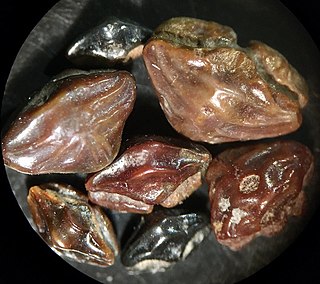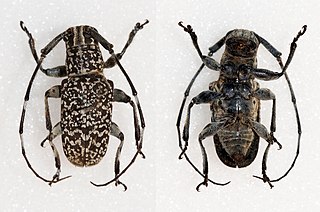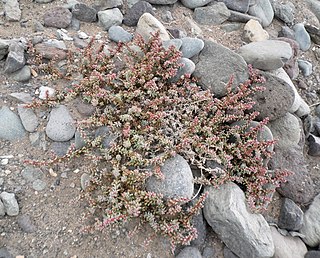Related Research Articles

Peckoltia is a genus of small South American armored suckermouth catfishes. Many of these fish are popular aquarium fish.

Gnophaela is a genus of tiger moths in the family Erebidae. The genus was erected by Francis Walker in 1854.

Eobania vermiculata also known as Helix vermiculata, common name the "chocolate-band snail" is a species of large, air-breathing, land snail, a terrestrial pulmonate gastropod mollusk in the family Helicidae, the true snails or typical snails.
Atrophodermia vermiculata presents with erythematous follicular papules on the cheeks in childhood and, with time, the lesions develop into pit-like depressions.

Gnophaela vermiculata, sometimes known as the police-car moth or green lattice, is a moth of the family Erebidae. The species was first described by Augustus Radcliffe Grote in 1864. It is found in the Rocky Mountain region of the United States and in western parts of North America, from British Columbia to California, east to New Mexico and north to Manitoba.

Suaeda vera, also known as shrubby sea-blite, shrubby seablight or in the USA sometimes as alkali seepweed, is a species of flowering plant in the family Amaranthaceae. It is a small shrub, with very variable appearance over its wide range. It is a halophyte, and occurs in arid and semi-arid saltflats, salt marshes and similar habitats.
Stenella vermiculata, formerly Cercospora capparidicola is a species of anamorphic fungi.
Eupithecia vermiculata is a moth in the family Geometridae. It is found in Colombia.

Herminia vermiculata is a litter moth of the family Erebidae first described by John Henry Leech in 1900. It is found in western China and Taiwan.
Marmaroglypha is a genus of longhorn beetles of the subfamily Lamiinae, containing the following species:

Ptychotrygon is a genus of sawfish-like Late Cretaceous ray whose fossils have been found worldwide. It, Ptychotrygonoides, Texatrygon, and Asflapristis are members of the family Ptychotrygonidae within the suborder Sclerorhynchoidei.

Salsola vermiculata, commonly known as Mediterranean saltwort, is a perennial plant in the family Amaranthaceae. It is native to arid and semi-arid regions of the Middle East, North Africa and southern Europe where it is used as a fodder plant for livestock.

Marmaroglypha pubescens is a species of beetle in the family Cerambycidae. It was described by Per Olof Christopher Aurivillius in 1898 and is known from the Philippines.
Marmaroglypha densepunctata is a species of beetle in the family Cerambycidae. It was described by Stephan von Breuning in 1948. It is known from Malaysia and Borneo.
Marmaroglypha fasciata is a species of beetle in the family Cerambycidae. It was described by Francis Polkinghorne Pascoe in 1869. It is known from Borneo and Malaysia.
Marmaroglypha sumatrana is a species of beetle in the family Cerambycidae. It was described by Ritsema in 1888. It is known from Sumatra.

Cacia vermiculata is a species of beetle in the family Cerambycidae. It was described by Heller in 1923. It is known from the Philippines.
Zonitis vermiculata is a species of blister beetle in the family Meloidae. It is found in North America.

Suaeda vermiculata is a species of plant in the family Amaranthaceae. It is a salt-tolerant plant (halophyte) that grows naturally in salt-affected areas.
Eremias vermiculata is a species of lizard found in Mongolia, China, and Kazakhstan. Eremias velox is also sometimes known as the Central Asian racerunner.
References
- ↑ BioLib.cz - Marmaroglypha vermiculata. Retrieved on 8 September 2014.